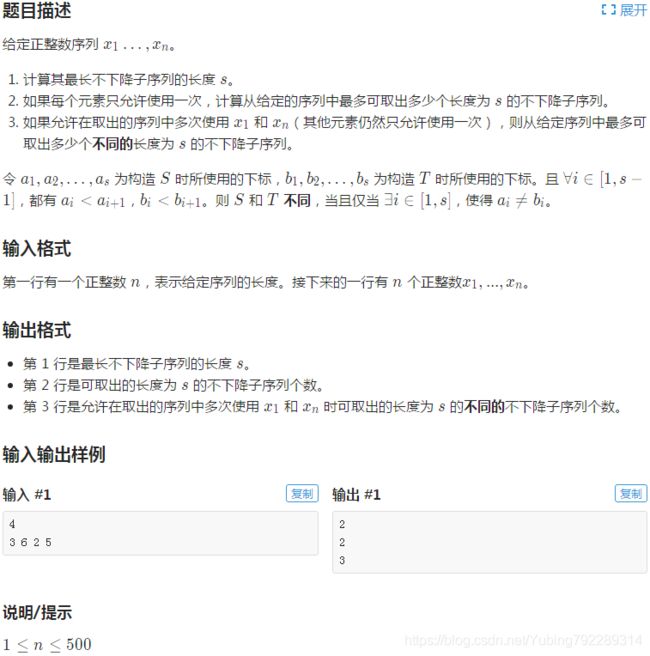- 洛谷二分查找题目详解
方俊涵
算法c++数据结构
B3881[信息与未来2015]拴奶牛题目描述有n头奶牛,有k个木桩,每个木桩有一个位置,一个木桩上只能拴一头奶牛。由于奶牛好斗,所以在拴奶牛的时候,要求距离最近的奶牛的距离尽可能大。例如n=4,k=6,木桩的位置为0,3,4,7,8,9,此时为下图。OllOOllOOO034789有许多种拴牛方案,例如:0,3,4,9:此时最近距离为1(3,4之间);0,3,7,9:此时最近距离为2。输入格式三
- 洛谷 B4262:[GESP202503 三级] 词频统计 ← STL map
hnjzsyjyj
信息学竞赛#STL标准库STLmap
【题目来源】https://www.luogu.com.cn/problem/B4262【题目描述】在文本处理中,统计单词出现的频率是一个常见的任务。现在,给定n个单词,你需要找出其中出现次数最多的单词。在本题中,忽略单词中字母的大小写(即Apple、apple、APPLE、aPPle等均视为同一个单词)。请你编写一个程序,输入n个单词,输出其中出现次数最多的单词。【输入格式】第一行,一个整数n,
- 算法竞赛备考冲刺必刷题(C++) | 洛谷 P1179 数字统计
本文分享的必刷题目是从蓝桥云课、洛谷、AcWing等知名刷题平台精心挑选而来,并结合各平台提供的算法标签和难度等级进行了系统分类。题目涵盖了从基础到进阶的多种算法和数据结构,旨在为不同阶段的编程学习者提供一条清晰、平稳的学习提升路径。欢迎大家订阅我的专栏:算法题解:C++与Python实现!附上汇总贴:算法竞赛备考冲刺必刷题(C++)|汇总【题目来源】洛谷:P1179[NOIP2010普及组]数字
- 算法竞赛备考冲刺必刷题(C++) | 洛谷 P1109 学生分组
热爱编程的通信人
算法c++开发语言
本文分享的必刷题目是从蓝桥云课、洛谷、AcWing等知名刷题平台精心挑选而来,并结合各平台提供的算法标签和难度等级进行了系统分类。题目涵盖了从基础到进阶的多种算法和数据结构,旨在为不同阶段的编程学习者提供一条清晰、平稳的学习提升路径。欢迎大家订阅我的专栏:算法题解:C++与Python实现!附上汇总贴:算法竞赛备考冲刺必刷题(C++)|汇总【题目来源】洛谷:P1109学生分组-洛谷【题目描述】有n
- 算法竞赛备考冲刺必刷题(C++) | 洛谷 P1449 后缀表达式
热爱编程的通信人
算法c++开发语言
本文分享的必刷题目是从蓝桥云课、洛谷、AcWing等知名刷题平台精心挑选而来,并结合各平台提供的算法标签和难度等级进行了系统分类。题目涵盖了从基础到进阶的多种算法和数据结构,旨在为不同阶段的编程学习者提供一条清晰、平稳的学习提升路径。欢迎大家订阅我的专栏:算法题解:C++与Python实现!附上汇总贴:算法竞赛备考冲刺必刷题(C++)|汇总【题目来源】洛谷:P1449后缀表达式-洛谷【题目描述】所
- 洛谷 P2947:[USACO09MAR] Look Up S ← 数组模拟+单调栈
hnjzsyjyj
信息学竞赛#栈与递归#STL标准库单调栈STLstack
【题目来源】https://www.luogu.com.cn/problem/P2947【题目描述】约翰的N(1≤N≤10^5)头奶牛站成一排,奶牛i的身高是Hi(1≤Hi≤10^6)。现在,每只奶牛都在向右看齐。对于奶牛i,如果奶牛j满足iusingnamespacestd;constintmaxn=1e6+5;inth[maxn],c[maxn];intstk[maxn];intn,top;i
- 洛谷 P11120 [ROIR 2024 Day 1] 登机 题解
殇之夜
洛谷c++c语言算法
Part0前言这种题一看就是签到题,也是特水,建议评红或橙。Part1思路就是先将已有位置先填对称,然后将剩余还未添加的乘客以对称方式填入。首先可以特判掉需要的位置大于空位的情况,直接输出Impossible。然后用数组记录.和X的位置,先遍历所有X的位置,然后看他的对称位置是否为空,若为空,则填入X,然后m--。最后若musingnamespacestd;chara[1010][10];stru
- 村村通--洛谷(并查集的运用)
P1536村村通题目描述某市调查城镇交通状况,得到现有城镇道路统计表。表中列出了每条道路直接连通的城镇。市政府“村村通工程”的目标是使全市任何两个城镇间都可以实现交通(但不一定有直接的道路相连,只要相互之间可达即可)。请你计算出最少还需要建设多少条道路?输入格式输入包含若干组测试测试数据,每组测试数据的第一行给出两个用空格隔开的正整数,分别是城镇数目n和道路数目m;随后的m行对应m条道路,每行给出
- 0-1背包问题(洛谷P1048采药)
题目描述辰辰是个天资聪颖的孩子,他的梦想是成为世界上最伟大的医师。为此,他想拜附近最有威望的医师为师。医师为了判断他的资质,给他出了一个难题。医师把他带到一个到处都是草药的山洞里对他说:“孩子,这个山洞里有一些不同的草药,采每一株都需要一些时间,每一株也有它自身的价值。我会给你一段时间,在这段时间里,你可以采到一些草药。如果你是一个聪明的孩子,你应该可以让采到的草药的总价值最大。”如果你是辰辰,你
- 洛谷 B3627 立方根--二分法求解整数立方根问题
jdlxx_dongfangxing
算法c++二分法
一、问题重述与数学建模给定一个正整数n,我们的目标是计算其立方根的整数部分,即找到最大的整数m满足m³≤n。这个问题可以形式化表述为:数学定义:⌊∛n⌋=max{x∈ℤ⁺|x³≤n}问题特性分析:单调性保证:立方函数f(x)=x³在正整数域上是严格单调递增的函数有界性:解的范围明确限定在[1,n]区间内离散性:我们需要寻找的是整数解而非实数解应用意义:该问题在实际中常用于需要快速估算立方根的场合,
- 洛谷P1010(递归法题解)
水木兰亭
每日一题算法线性回归c++学习分类
————————————本文旨在讨论计算机知识,欢迎指正——————————————输入输出样例输入1315输出2(2(2+2(0))+2)+2(2(2+2(0)))+2(2(2)+2(0))+2+2(0)说明/提示【数据范围】对于100%的数据,1≤n≤2×104。1≤n≤2×104首先,我们观察这道题,笔者看到这道题一开始也是很懵,关于如何输出这种长长的一行,但是,我们经过拆解可以发现:2的十
- 洛谷 P2107 小Z的AK计划
zhanghengjie20120214
算法c++贪心算法
题目描述在小Z的家乡,有机房一条街,街上有很多机房。每个机房里都有一万个人在切题。小Z刚刷完CodeChef,准备出来逛逛。机房一条街有n个机房,第i个机房的坐标为xi,小Z的家坐标为0。小Z在街上移动的速度为1,即从x1到x2所耗费的时间为∣x1−x2∣。每个机房的学生数量不同,ACM题目水平也良莠不齐。小Z到达第i个机房后,可以花ti的时间想题,然后瞬间AK;当然,也可以过机房而不入。小Z现在
- 暑假算法刷题日记 Day 10
mjh_yylx
算法刷题打卡算法
目录重点整理054、拼数题目描述输入格式输出格式输入输出样例核心思路代码055、求第k小的数题目描述输入格式输出格式输入输出样例核心思路代码总结这几天我们主要刷了洛谷上排序算法对应的一些题目,相对来说比较简单一共是13道题,对应我暑假刷题的043--055。当然这些题目相对来说比较简单,我们挑着重点的说。重点整理排序这一块的题目总体来看包括,1.基本的排序算法,像快速排序、分治排序,这些知识点我写
- 洛谷-分支结构
pay4fun
刷题算法c++开发语言
洛谷–分支结构题目来源于洛谷,若有侵权,私信后立刻删除P5709【深基2.习6】ApplesPrologue/苹果和虫子题目描述小B喜欢吃苹果。她现在有mmm(1≤m≤1001\lem\le1001≤m≤100)个苹果,吃完一个苹果需要花费ttt(0≤t≤1000\let\le1000≤t≤100)分钟,吃完一个后立刻开始吃下一个。现在时间过去了sss(1≤s≤100001\les\le10000
- 洛谷分支结构题单刷题记录 java
阿乌阿呜
JAVA刷题记录java算法
目录P2433【深基1-2】小学数学N合一P5709【深基2.习6】ApplesPrologue/苹果和虫子P5710【深基3.例2】数的性质P5711【深基3.例3】闰年判断P5712【深基3.例4】ApplesP5713【深基3.例5】洛谷团队系统P5714【深基3.例7】肥胖问题P5715【深基3.例8】三位数排序P5716【深基3.例9】月份天数P1085[NOIP2004普及组]不高兴的
- 洛谷 P3378 【模板】堆
Liangwei Lin
算法数据结构
题目描述给定一个数列,初始为空,请支持下面三种操作:给定一个整数x,请将x加入到数列中。输出数列中最小的数。删除数列中最小的数(如果有多个数最小,只删除1个)。输入格式第一行是一个整数,表示操作的次数n。接下来n行,每行表示一次操作。每行首先有一个整数op表示操作类型。若op=1,则后面有一个整数x,表示要将x加入数列。若op=2,则表示要求输出数列中的最小数。若op=3,则表示删除数列中的最小数
- 搜索之BFS
Luther coder
宽度优先c++
目录一.BFS简介二.BFS主要应用和实现三.典型例题(1)P1443马的遍历-洛谷(2)P8693[蓝桥杯2019国AC]大胖子走迷宫-洛谷四.总结一.BFS简介BFS(图论):广度优先搜索,是一种用于遍历或搜索树或图的算法。所谓广度优先,就是说按照圈层搜索。二.BFS主要应用和实现在搜索算法中,该BFS常常指利用队列实现广度优先搜索,从而寻找最短距离。与图论中的BFS算法有一定相似之处,但并不
- 区间动态规划
Luther coder
动态规划算法
目录一.区间dp简介二.模板代码三.典型例题(1)P4170[CQOI2007]涂色-洛谷三.总结一.区间dp简介区间dp:就是对于区间的一种动态规划,它将问题划分为若干个子区间,并通过定义状态和状态转移方程来求解每个子区间的最优解,最终得到整个区间的最优解。对于某个区间,它的合并方式可能有很多种,我们需要去枚举所有的方式,通常是去枚举区间的分割点,找到最优的方式(一般是找最少消耗)。例如:对于区
- 洛谷 P13016 [GESP202506 六级] 最大因数-普及/提高-
智趣代码实验室
洛谷算法数据结构洛谷c++
题目描述给定一棵有10910^9109个结点的有根树,这些结点依次以1,2,…,1091,2,\dots,10^91,2,…,109编号,根结点的编号为111。对于编号为kkk(2≤k≤1092\leqk\leq10^92≤k≤109)的结点,其父结点的编号为kkk的因数中除kkk以外最大的因数。现在有qqq组询问,第iii(1≤i≤q1\leqi\leqq1≤i≤q)组询问给定xi,yix_i,
- 洛谷 P11251 [GESP202409 八级] 美丽路径-普及/提高-
智趣代码实验室
洛谷算法深度优先图论洛谷
题目描述小杨有一棵包含nnn个节点的树,节点从111到nnn编号。每个节点要么是白色,要么是黑色。对于树上的一条简单路径(不经过重复节点的路径),小杨认为它是美丽的当且仅当路径上相邻节点的颜色均不相同。例如下图,其中节点111和节点444是黑色,其余节点是白色,路径2−1−3−42-1-3-42−1−3−4是美丽路径,而路径2−1−3−52-1-3-52−1−3−5不是美丽路径(相邻节点333和5
- 洛谷P4317 花神的数论题题解
cwplh
题解算法图论
题目传送门本体接主要是对小粉兔大佬的题解的进一步解释。题目中让我们求∏i=1Nsum(i)\prod_{i=1}^N\operatorname{sum}(i)∏i=1Nsum(i),很明显不能直接暴力枚举求解,因此我们稍微归个类:把sum(i)\operatorname{sum}(i)sum(i)值相同的iii放在一起,假设sum(i)\operatorname{sum}(i)sum(i)值
- 洛谷刷题8
eurotruck
c++算法图论洛谷刷题
B2051点和正方形的关系B2051点和正方形的关系-洛谷难度:入门如果x1||y1,那么点就在正方形外,反之亦然AC代码:#includeusingnamespacestd;intmain(){#defineintlonglongintx,y;cin>>x>>y;if(x>=-1&&xusingnamespacestd;intmain(){intm,n;cin>>m;cin>>n;intr=0;
- MYOJ_5078:(洛谷P5662)[CSP-J2019] 纪念品(完全背包提高)
Jayfeather松鸦羽_sch
NOIP+CSP系列题解背包DP(不同于动规)算法动态规划c++
题目描述小伟突然获得一种超能力,他知道未来T天N种纪念品每天的价格。某个纪念品的价格是指购买一个该纪念品所需的金币数量,以及卖出一个该纪念品换回的金币数量。每天,小伟可以进行以下两种交易无限次:任选一个纪念品,若手上有足够金币,以当日价格购买该纪念品;卖出持有的任意一个纪念品,以当日价格换回金币。每天卖出纪念品换回的金币可以立即用于购买纪念品,当日购买的纪念品也可以当日卖出换回金币。当然,一直持有
- 洛谷P1966 [NOIP 2013 提高组] 火柴排队
xwztdas
模拟算法数据结构动态规划
洛谷P1966[NOIP2013提高组]火柴排队洛谷题目传送门题目背景NOIP2013提高组D1T2题目描述涵涵有两盒火柴,每盒装有nnn根火柴,每根火柴都有一个高度。现在将每盒中的火柴各自排成一列,同一列火柴的高度互不相同,两列火柴之间的距离定义为:$\sum(a_i-b_i)^2$。其中aia_iai表示第一列火柴中第iii个火柴的高度,bib_ibi表示第二列火柴中第iii个火柴的高度。每列
- 第三届“传智杯”全国大学生IT技能大赛(初赛B组)
START_GAME
实战笔记
第三届“传智杯”全国大学生IT技能大赛(初赛B组)链接:https://www.luogu.com.cn/contest/38442#description也直接洛谷进入———————————————————————————————笔记:前三题不难。卡在第四题(提交了18次才过-_-),测试点二就是过不了。变量创建的位置改一下就过了,非常不明白为什么。虽然最后5题都过了,估计还是凉凉300+。T1
- FHQ无旋平衡树可持久化详解
xwztdas
线段树/平衡树FHQTreap平衡树数据结构可持久化
引入在上一篇题解,我们研究了FHQ实现维护有序序列与区间翻转,在这一篇题解,我们将要探讨关于FHQ实现可持久化的操作。例题洛谷P3835【模板】可持久化平衡树由题目可得这显然必须使用可持久化,我们先了解一下什么是可持久化。可持久化定义可持久化是指一个数据结构在修改操作(如插入、删除、更新)后,仍然保留其修改前的版本,并且能够同时访问修改前和修改后的所有历史版本。他的关键特征如下:保留历史版本:每次
- 【洛谷】P1001 A+B Problem
h+1叻
c++编程算法
这种简单的题目怎么能少的了我呢,嘿嘿题目描述输入两个整数x,yx,y,输出它们的和(|x|,|y|\le{10}^9)(∣x∣,∣y∣≤109)。输入格式一行,两个整数x,yx,y,0\leqx,y\leq327670≤x,y≤32767.输出格式一个整数,x与yx与y的和.样例输入数据1123500输出数据1623时间及内存限制1s,1024KiBforeachtestcase.这道题有亿点,看
- 【题解】洛谷P1001 A+B Problem
炯炯目光
c++
写在前面第一篇博客,献给2020年的残夏。静听8月的热情与安宁,在竞赛中的时光如白驹过隙。也不惧未知的风雨,努力向着既往的通途。ACMACMACM的目标,希望能实现吧。同时,推荐一下我的个人博客,欢迎访问。https://www.cnblogs.com/jjmg/下面是页面编辑的测试。题目地址https://www.luogu.com.cn/problem/P1001题目描述输入两个整数a,ba,
- 洛谷 P3379 【模板】最近公共祖先(LCA)普及/提高-
智趣代码实验室
算法数据结构洛谷c++
题目描述如题,给定一棵有根多叉树,请求出指定两个点直接最近的公共祖先。输入格式第一行包含三个正整数N,M,SN,M,SN,M,S,分别表示树的结点个数、询问的个数和树根结点的序号。接下来N−1N-1N−1行每行包含两个正整数x,yx,yx,y,表示xxx结点和yyy结点之间有一条直接连接的边(数据保证可以构成树)。接下来MMM行每行包含两个正整数a,ba,ba,b,表示询问aaa结点和bbb结点的
- 编程c++ 洛谷P1001 A+B Problem
zcc_qwq
c++java算法
hello大家好,我又来了。A+B问题c++初学者都会,很很很很……(此处省略1000000个)简单带马:#include//万能头文件usingnamespacestd;inta,b;//两个整型变量intmain(){cin>>a>>b;//输入cout<<a+b;//输出return0;}简单简单简单简单鸡蛋,我用小脚趾都做得出来,呵呵……大家下会见
- iOS http封装
374016526
ios服务器交互http网络请求
程序开发避免不了与服务器的交互,这里打包了一个自己写的http交互库。希望可以帮到大家。
内置一个basehttp,当我们创建自己的service可以继承实现。
KuroAppBaseHttp *baseHttp = [[KuroAppBaseHttp alloc] init];
[baseHttp setDelegate:self];
[baseHttp
- lolcat :一个在 Linux 终端中输出彩虹特效的命令行工具
brotherlamp
linuxlinux教程linux视频linux自学linux资料
那些相信 Linux 命令行是单调无聊且没有任何乐趣的人们,你们错了,这里有一些有关 Linux 的文章,它们展示着 Linux 是如何的有趣和“淘气” 。
在本文中,我将讨论一个名为“lolcat”的小工具 – 它可以在终端中生成彩虹般的颜色。
何为 lolcat ?
Lolcat 是一个针对 Linux,BSD 和 OSX 平台的工具,它类似于 cat 命令,并为 cat
- MongoDB索引管理(1)——[九]
eksliang
mongodbMongoDB管理索引
转载请出自出处:http://eksliang.iteye.com/blog/2178427 一、概述
数据库的索引与书籍的索引类似,有了索引就不需要翻转整本书。数据库的索引跟这个原理一样,首先在索引中找,在索引中找到条目以后,就可以直接跳转到目标文档的位置,从而使查询速度提高几个数据量级。
不使用索引的查询称
- Informatica参数及变量
18289753290
Informatica参数变量
下面是本人通俗的理解,如有不对之处,希望指正 info参数的设置:在info中用到的参数都在server的专门的配置文件中(最好以parma)结尾 下面的GLOBAl就是全局的,$开头的是系统级变量,$$开头的变量是自定义变量。如果是在session中或者mapping中用到的变量就是局部变量,那就把global换成对应的session或者mapping名字。
[GLOBAL] $Par
- python 解析unicode字符串为utf8编码字符串
酷的飞上天空
unicode
php返回的json字符串如果包含中文,则会被转换成\uxx格式的unicode编码字符串返回。
在浏览器中能正常识别这种编码,但是后台程序却不能识别,直接输出显示的是\uxx的字符,并未进行转码。
转换方式如下
>>> import json
>>> q = '{"text":"\u4
- Hibernate的总结
永夜-极光
Hibernate
1.hibernate的作用,简化对数据库的编码,使开发人员不必再与复杂的sql语句打交道
做项目大部分都需要用JAVA来链接数据库,比如你要做一个会员注册的 页面,那么 获取到用户填写的 基本信后,你要把这些基本信息存入数据库对应的表中,不用hibernate还有mybatis之类的框架,都不用的话就得用JDBC,也就是JAVA自己的,用这个东西你要写很多的代码,比如保存注册信
- SyntaxError: Non-UTF-8 code starting with '\xc4'
随便小屋
python
刚开始看一下Python语言,传说听强大的,但我感觉还是没Java强吧!
写Hello World的时候就遇到一个问题,在Eclipse中写的,代码如下
'''
Created on 2014年10月27日
@author: Logic
'''
print("Hello World!");
运行结果
SyntaxError: Non-UTF-8
- 学会敬酒礼仪 不做酒席菜鸟
aijuans
菜鸟
俗话说,酒是越喝越厚,但在酒桌上也有很多学问讲究,以下总结了一些酒桌上的你不得不注意的小细节。
细节一:领导相互喝完才轮到自己敬酒。敬酒一定要站起来,双手举杯。
细节二:可以多人敬一人,决不可一人敬多人,除非你是领导。
细节三:自己敬别人,如果不碰杯,自己喝多少可视乎情况而定,比如对方酒量,对方喝酒态度,切不可比对方喝得少,要知道是自己敬人。
细节四:自己敬别人,如果碰杯,一
- 《创新者的基因》读书笔记
aoyouzi
读书笔记《创新者的基因》
创新者的基因
创新者的“基因”,即最具创意的企业家具备的五种“发现技能”:联想,观察,实验,发问,建立人脉。
第一部分破坏性创新,从你开始
第一章破坏性创新者的基因
如何获得启示:
发现以下的因素起到了催化剂的作用:(1) -个挑战现状的问题;(2)对某项技术、某个公司或顾客的观察;(3) -次尝试新鲜事物的经验或实验;(4)与某人进行了一次交谈,为他点醒
- 表单验证技术
百合不是茶
JavaScriptDOM对象String对象事件
js最主要的功能就是验证表单,下面是我对表单验证的一些理解,贴出来与大家交流交流 ,数显我们要知道表单验证需要的技术点, String对象,事件,函数
一:String对象;通常是对字符串的操作;
1,String的属性;
字符串.length;表示该字符串的长度;
var str= "java"
- web.xml配置详解之context-param
bijian1013
javaservletweb.xmlcontext-param
一.格式定义:
<context-param>
<param-name>contextConfigLocation</param-name>
<param-value>contextConfigLocationValue></param-value>
</context-param>
作用:该元
- Web系统常见编码漏洞(开发工程师知晓)
Bill_chen
sqlPHPWebfckeditor脚本
1.头号大敌:SQL Injection
原因:程序中对用户输入检查不严格,用户可以提交一段数据库查询代码,根据程序返回的结果,
获得某些他想得知的数据,这就是所谓的SQL Injection,即SQL注入。
本质:
对于输入检查不充分,导致SQL语句将用户提交的非法数据当作语句的一部分来执行。
示例:
String query = "SELECT id FROM users
- 【MongoDB学习笔记六】MongoDB修改器
bit1129
mongodb
本文首先介绍下MongoDB的基本的增删改查操作,然后,详细介绍MongoDB提供的修改器,以完成各种各样的文档更新操作 MongoDB的主要操作
show dbs 显示当前用户能看到哪些数据库
use foobar 将数据库切换到foobar
show collections 显示当前数据库有哪些集合
db.people.update,update不带参数,可
- 提高职业素养,做好人生规划
白糖_
人生
培训讲师是成都著名的企业培训讲师,他在讲课中提出的一些观点很新颖,在此我收录了一些分享一下。注:讲师的观点不代表本人的观点,这些东西大家自己揣摩。
1、什么是职业规划:职业规划并不完全代表你到什么阶段要当什么官要拿多少钱,这些都只是梦想。职业规划是清楚的认识自己现在缺什么,这个阶段该学习什么,下个阶段缺什么,又应该怎么去规划学习,这样才算是规划。
- 国外的网站你都到哪边看?
bozch
技术网站国外
学习软件开发技术,如果没有什么英文基础,最好还是看国内的一些技术网站,例如:开源OSchina,csdn,iteye,51cto等等。
个人感觉如果英语基础能力不错的话,可以浏览国外的网站来进行软件技术基础的学习,例如java开发中常用的到的网站有apache.org 里面有apache的很多Projects,springframework.org是spring相关的项目网站,还有几个感觉不错的
- 编程之美-光影切割问题
bylijinnan
编程之美
package a;
public class DisorderCount {
/**《编程之美》“光影切割问题”
* 主要是两个问题:
* 1.数学公式(设定没有三条以上的直线交于同一点):
* 两条直线最多一个交点,将平面分成了4个区域;
* 三条直线最多三个交点,将平面分成了7个区域;
* 可以推出:N条直线 M个交点,区域数为N+M+1。
- 关于Web跨站执行脚本概念
chenbowen00
Web安全跨站执行脚本
跨站脚本攻击(XSS)是web应用程序中最危险和最常见的安全漏洞之一。安全研究人员发现这个漏洞在最受欢迎的网站,包括谷歌、Facebook、亚马逊、PayPal,和许多其他网站。如果你看看bug赏金计划,大多数报告的问题属于 XSS。为了防止跨站脚本攻击,浏览器也有自己的过滤器,但安全研究人员总是想方设法绕过这些过滤器。这个漏洞是通常用于执行cookie窃取、恶意软件传播,会话劫持,恶意重定向。在
- [开源项目与投资]投资开源项目之前需要统计该项目已有的用户数
comsci
开源项目
现在国内和国外,特别是美国那边,突然出现很多开源项目,但是这些项目的用户有多少,有多少忠诚的粉丝,对于投资者来讲,完全是一个未知数,那么要投资开源项目,我们投资者必须准确无误的知道该项目的全部情况,包括项目发起人的情况,项目的维持时间..项目的技术水平,项目的参与者的势力,项目投入产出的效益.....
- oracle alert log file(告警日志文件)
daizj
oracle告警日志文件alert log file
The alert log is a chronological log of messages and errors, and includes the following items:
All internal errors (ORA-00600), block corruption errors (ORA-01578), and deadlock errors (ORA-00060)
- 关于 CAS SSO 文章声明
denger
SSO
由于几年前写了几篇 CAS 系列的文章,之后陆续有人参照文章去实现,可都遇到了各种问题,同时经常或多或少的收到不少人的求助。现在这时特此说明几点:
1. 那些文章发表于好几年前了,CAS 已经更新几个很多版本了,由于近年已经没有做该领域方面的事情,所有文章也没有持续更新。
2. 文章只是提供思路,尽管 CAS 版本已经发生变化,但原理和流程仍然一致。最重要的是明白原理,然后
- 初二上学期难记单词
dcj3sjt126com
englishword
lesson 课
traffic 交通
matter 要紧;事物
happy 快乐的,幸福的
second 第二的
idea 主意;想法;意见
mean 意味着
important 重要的,重大的
never 从来,决不
afraid 害怕 的
fifth 第五的
hometown 故乡,家乡
discuss 讨论;议论
east 东方的
agree 同意;赞成
bo
- uicollectionview 纯代码布局, 添加头部视图
dcj3sjt126com
Collection
#import <UIKit/UIKit.h>
@interface myHeadView : UICollectionReusableView
{
UILabel *TitleLable;
}
-(void)setTextTitle;
@end
#import "myHeadView.h"
@implementation m
- N 位随机数字串的 JAVA 生成实现
FX夜归人
javaMath随机数Random
/**
* 功能描述 随机数工具类<br />
* @author FengXueYeGuiRen
* 创建时间 2014-7-25<br />
*/
public class RandomUtil {
// 随机数生成器
private static java.util.Random random = new java.util.R
- Ehcache(09)——缓存Web页面
234390216
ehcache页面缓存
页面缓存
目录
1 SimplePageCachingFilter
1.1 calculateKey
1.2 可配置的初始化参数
1.2.1 cach
- spring中少用的注解@primary解析
jackyrong
primary
这次看下spring中少见的注解@primary注解,例子
@Component
public class MetalSinger implements Singer{
@Override
public String sing(String lyrics) {
return "I am singing with DIO voice
- Java几款性能分析工具的对比
lbwahoo
java
Java几款性能分析工具的对比
摘自:http://my.oschina.net/liux/blog/51800
在给客户的应用程序维护的过程中,我注意到在高负载下的一些性能问题。理论上,增加对应用程序的负载会使性能等比率的下降。然而,我认为性能下降的比率远远高于负载的增加。我也发现,性能可以通过改变应用程序的逻辑来提升,甚至达到极限。为了更详细的了解这一点,我们需要做一些性能
- JVM参数配置大全
nickys
jvm应用服务器
JVM参数配置大全
/usr/local/jdk/bin/java -Dresin.home=/usr/local/resin -server -Xms1800M -Xmx1800M -Xmn300M -Xss512K -XX:PermSize=300M -XX:MaxPermSize=300M -XX:SurvivorRatio=8 -XX:MaxTenuringThreshold=5 -
- 搭建 CentOS 6 服务器(14) - squid、Varnish
rensanning
varnish
(一)squid
安装
# yum install httpd-tools -y
# htpasswd -c -b /etc/squid/passwords squiduser 123456
# yum install squid -y
设置
# cp /etc/squid/squid.conf /etc/squid/squid.conf.bak
# vi /etc/
- Spring缓存注解@Cache使用
tom_seed
spring
参考资料
http://www.ibm.com/developerworks/cn/opensource/os-cn-spring-cache/
http://swiftlet.net/archives/774
缓存注解有以下三个:
@Cacheable @CacheEvict @CachePut
- dom4j解析XML时出现"java.lang.noclassdeffounderror: org/jaxen/jaxenexception"错误
xp9802
java.lang.NoClassDefFoundError: org/jaxen/JaxenExc
关键字: java.lang.noclassdeffounderror: org/jaxen/jaxenexception
使用dom4j解析XML时,要快速获取某个节点的数据,使用XPath是个不错的方法,dom4j的快速手册里也建议使用这种方式
执行时却抛出以下异常:
Exceptio


